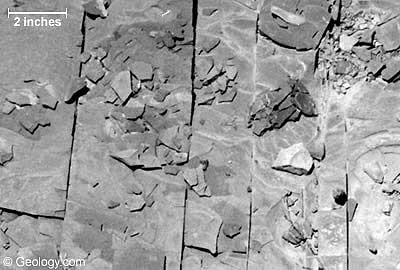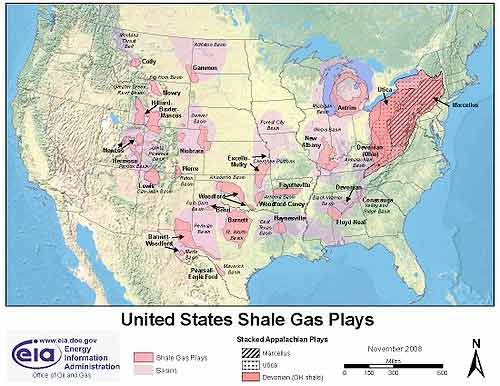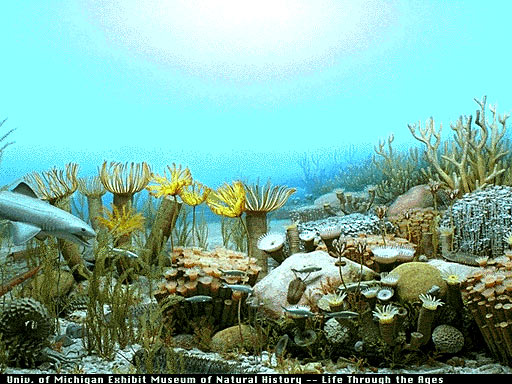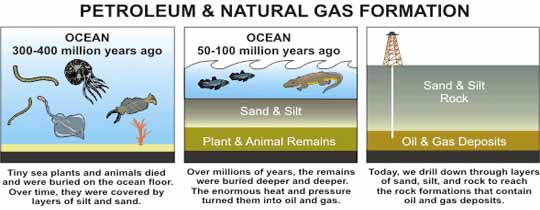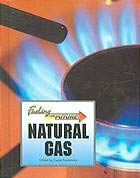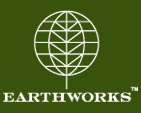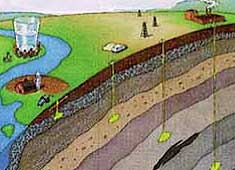Biblio
Shale gas in the United States is rapidly increasing as a source of natural gas. Led by new applications of hydraulic fracturing technology and horizontal drilling, development of new sources of shale gas has offset declines in production from conventional gas reservoirs, and has led to major increases in reserves of US natural gas.
Please note that information taken from Wikipedia should be verified using other, more reliable sources. It is a good place to start research, but because anyone can edit Wikipedia, we do not recommend using it in research papers or to obtain highly reliable information.
Nolan Hart. (2008). Includes photos, maps, illustrations.
Named for the town of Marcellus New York, where the shale reaches the surface, it is a Devonian age (roughly 390 million years old) member of a geological structure known as the Hamilton group. It formed when Devonian age seas...covered much of North America.
Natural Gas Informational Site by the U.S. Department of Energy (U.S. DOE). Includes articles on How Do We Get Natural Gas?, How Was Natural Gas Formed? Also article on Energy Explained, Use of Natural Gas, Delivery and Storage of Natural Gas, How Much Natural Gas Is Left.
Molly Ivins has written about how the EPA was virtually dismantled as the Bush-Cheney administration handed over the role of oil and gas regulation to the oil and gas industry. While Governor of Texas, Bush allowed Texas industry to voluntarily comply with Federal Clean Air Regulations. Of the hundreds of Texas companies that might have volunteered, according to Ivins, only three did.
Bushwhacked by Molly ivins offers a critique of the presidency of George W. Bush, describing how the same flawed policies he used to govern Texas have affected health and safety standards, the economy, and the environment.
Paul Krugman. Strictly Business. Bushwhacked: Life in George W. Bush’s America Book Review. The New York Review of Books. November 20, 2003.
Chapter 9 of Bushwhacked, by Molly Ivins and Lou Dubose, entitled “Dick, Dubya, and Wyoming Methane,” tells you all you need to know about the Bush Interior Department.
We learn, in particular, that J. Steven Griles, the deputy secretary—and probably the real power in the department—has spent his career shuttling back and forth between being a government official and lobbying for the extractive industries.
And he has never worried much about ethical niceties—little things like recusing himself from decisions that affect his former clients. Moreover, Griles isn’t likely to be disciplined, even when he brazenly supports industry interests over the judgments of government experts.
After all, just about every other senior official at Interior, including Secretary Gale Norton, has a similar résumé. So it’s a very good bet that the new rules on mining-waste disposal don’t reflect a careful economic analysis of the pros and cons.
See: Ed Swartz: The Grass Isn't Growing
See: Stripping the West, a NOW Converstion with Bill Moyers.
See C-Span Book TV Oct. 2, 2004. Bushwacked: Life in George W. Bush's America. Read Chapter: "Dick, Dubya, and Wyoming Methane." (152)
See: U.S. Environmental Protection Agency (EPA): Hydraulic Fracturing Study (2010-2012)
Fracking will require the storage of frack wastewater in pits.
There are many fluids and wastes associated with oil and gas operations that can poison living organisms. This web page contains information on some of the following issues of concern related to the storage and disposal of oil and gas wastes:
- How pit pollution occurs
- Soil and water contamination from pits
- Wildlife and livestock mortality related to pits
- Toxic materials stored and disposed of in pits
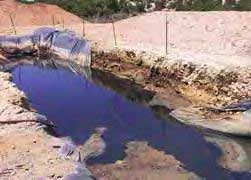

Rep. Henry A. Waxman, D-Calif.
"Two of the largest companies involved in natural gas drilling have acknowledged pumping hundreds of thousands of gallons of diesel-based fluids into the ground in the process of hydraulic fracturing, raising further concerns that existing state and federal regulations don't adequately protect drinking water from drilling."
Source: Energy and Commerce Committee Investigates Potential Impacts of Hydraulic Fracturing
Cornell University Cooperative Extension. Landowner Information. Links to Landowner Coalitions, Key Points for Property Owners, Gas Rights and Right-of-Way Leasing Considerations for Farms. Woodlands, and more.
See also: Cornell Cooperative Extension (CCE): Natural Gas Resource Center
 The Clean Water Act is the primary federal law in the United States governing water pollution. Commonly abbreviated as the CWA, the act established the goals of eliminating releases to water of high amounts of toxic substances, eliminating additional water pollution by 1985, and ensuring that surface waters would meet standards necessary for human sports and recreation by 1983.
The Clean Water Act is the primary federal law in the United States governing water pollution. Commonly abbreviated as the CWA, the act established the goals of eliminating releases to water of high amounts of toxic substances, eliminating additional water pollution by 1985, and ensuring that surface waters would meet standards necessary for human sports and recreation by 1983.
The principal body of law currently in effect is based on the Federal Water Pollution Control Amendments of 1972, which significantly expanded and strengthened earlier legislation. Major amendments were enacted in the Clean Water Act of 1977 and the Water Quality Act of 1987.
Please note that information taken from Wikipedia should be verified using other, more reliable sources. It is a good place to start research, but because anyone can edit Wikipedia, we do not recommend using it in research papers or to obtain highly reliable information.
The Safe Drinking Water Act (SDWA 1974) is the principal federal law in the United States that ensures safe drinking water for the public. Pursuant to the act, the Environmental Protection Agency (EPA) is required to set standards for drinking water quality and oversee all states, localities, and water suppliers who implement these standards.
SDWA applies to every public water system in the United States. There are currently more than 160,000 public water systems providing water to almost all Americans at some time in their lives. The Act does not cover private wells.
In 1996, Congress amended the Safe Drinking Water Act amendments to emphasize sound science and risk-based standard setting, small water supply system flexibility and technical assistance, community-empowered source water assessment and protection, public right-to-know, and water system infrastructure assistance through a multi-billion-dollar state revolving loan fund. They were signed into law by President Bill Clinton on August 6, 1996.
See: Safe Drinking Water Act 101 | Online Training | Drinking Water Academy
Please note that information taken from Wikipedia should be verified using other, more reliable sources. It is a good place to start research, but because anyone can edit Wikipedia, we do not recommend using it in research papers or to obtain highly reliable information.
More than three decades after the Clean Water Act, iconic American waterways like the Chesapeake Bay and Puget Sound are in perilous condition and facing new sources of contamination.
With polluted runoff still flowing in from industry, agriculture and massive suburban development, scientists note that many new pollutants and toxins from modern everyday life are already being found in the drinking water of millions of people across the country and pose a threat to fish, wildlife and, potentially, human health.
In Poisoned Waters, Pulitzer Prize-winning journalist Hedrick Smith examines the growing hazards to human health and the ecosystem...
...In addition to assessing the scope of America's polluted-water problem, Poisoned Waters highlights several cases in which grassroots citizens' groups succeeded in effecting environmental change: In South Park, Wash., incensed residents pushed for better cleanup of PCB contamination that remained from an old asphalt plant. In Loudon County, Va., residents prevented a large-scale housing development that would have overwhelmed already-strained stormwater systems believed to contribute to the contamination in Chesapeake Bay.
See Credits.
Abrahm Lustgarten
Gas drilling companies such as Halliburton say the gas drilling technique known as hydraulic fracturing, or "fracking," is safe, but opponents contend it pollutes groundwater with dangerous substances. Now, new evidence has emerged possibly linking natural gas drilling to groundwater contamination.
ProPublica journalist Abrahm Lustgarten reports federal officials in Wyoming have found that at least three water wells contain chemicals used in hydraulic fracturing.
Abrahm Lustgarten is a former staff writer and contributor for Fortune, and has written for Salon, Esquire, the Washington Post and the New York Times since receiving his master's in journalism from Columbia University in 2003.
Summary Points:
EPA’s central authority to protect drinking water is drawn from the Safe Drinking Water Act (SDWA).
The SDWA requires EPA to set legal limits on the levels of certain contaminants in drinking water.
The Safe Drinking Water Act (SDWA) also requires EPA to protect underground sources of drinking water (USDWs) from contamination caused by underground injection.
-
§1421 provides minimum standards for underground injection.
-
§1422 provides for state primary enforcement authority.
-
§1425 provides for alternative showing of effectiveness of program by state Underground Injection Control (UIC) Programs (Oil and Gas wells only).
-
§1431 contains provisions to address imminent and substantial endangerment.
Activities not regulated under Safe Drinking Water Act (SDWA) Provisions for UIC (Sections 1421, 1422, and 1425).
-
Oil and gas production activities.
-
Hydraulic fracturing (except use of diesel) per 2005 Energy Policy Act.
-
Natural gas storage.
States may choose to regulate these activities.
Surface water discharges are regulated under the Clean Water Act (CWA).
See: Safe Drinking Water Act (SDWA) | Safe Drinking Water Act | US EPA
See: Coalbed Methane Development: The Costs and Benefits of an Emerging Energy Resource
See: WATER | Safe Drinking Water Act - Wikipedia, the free encyclopedia





